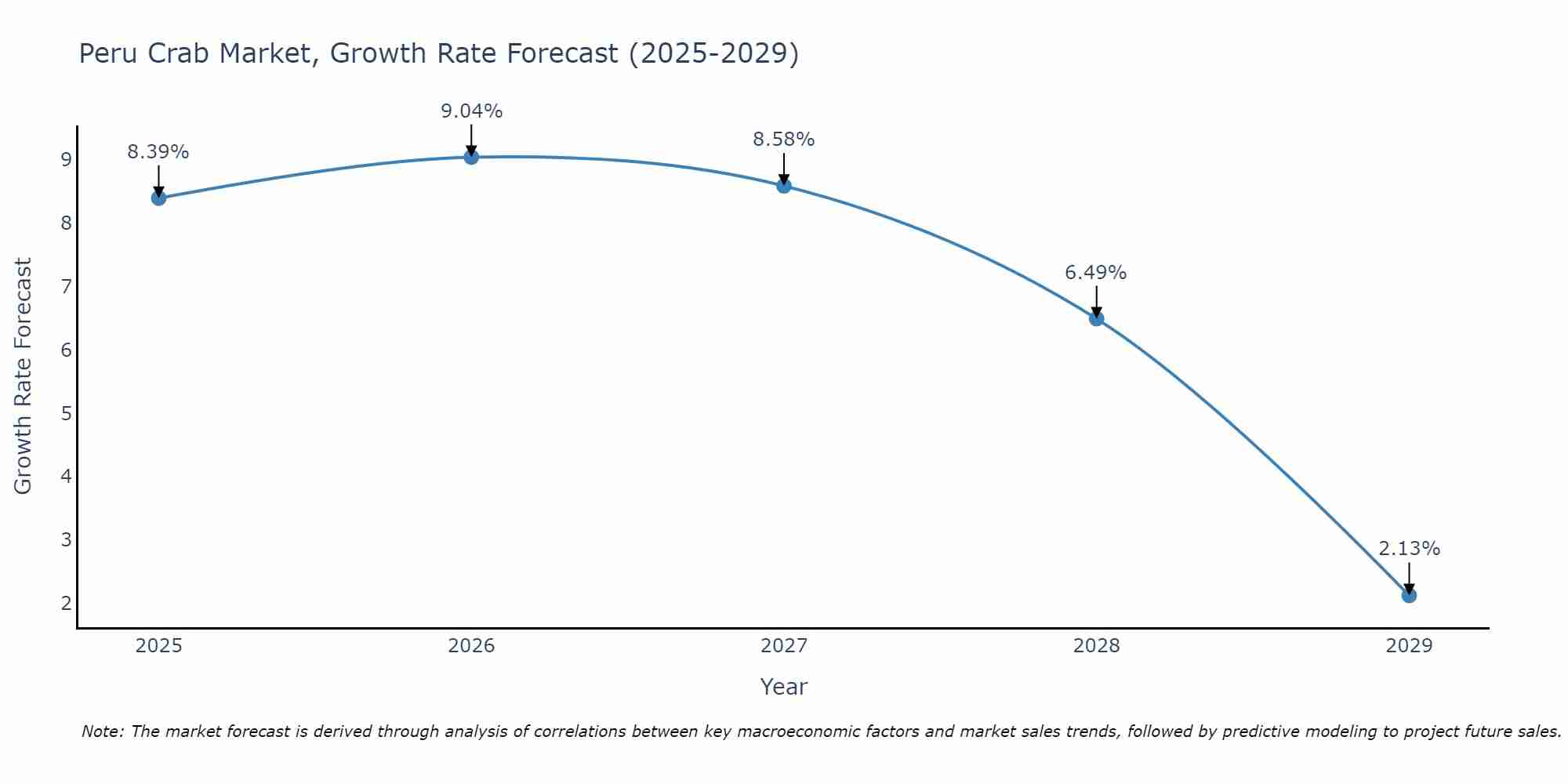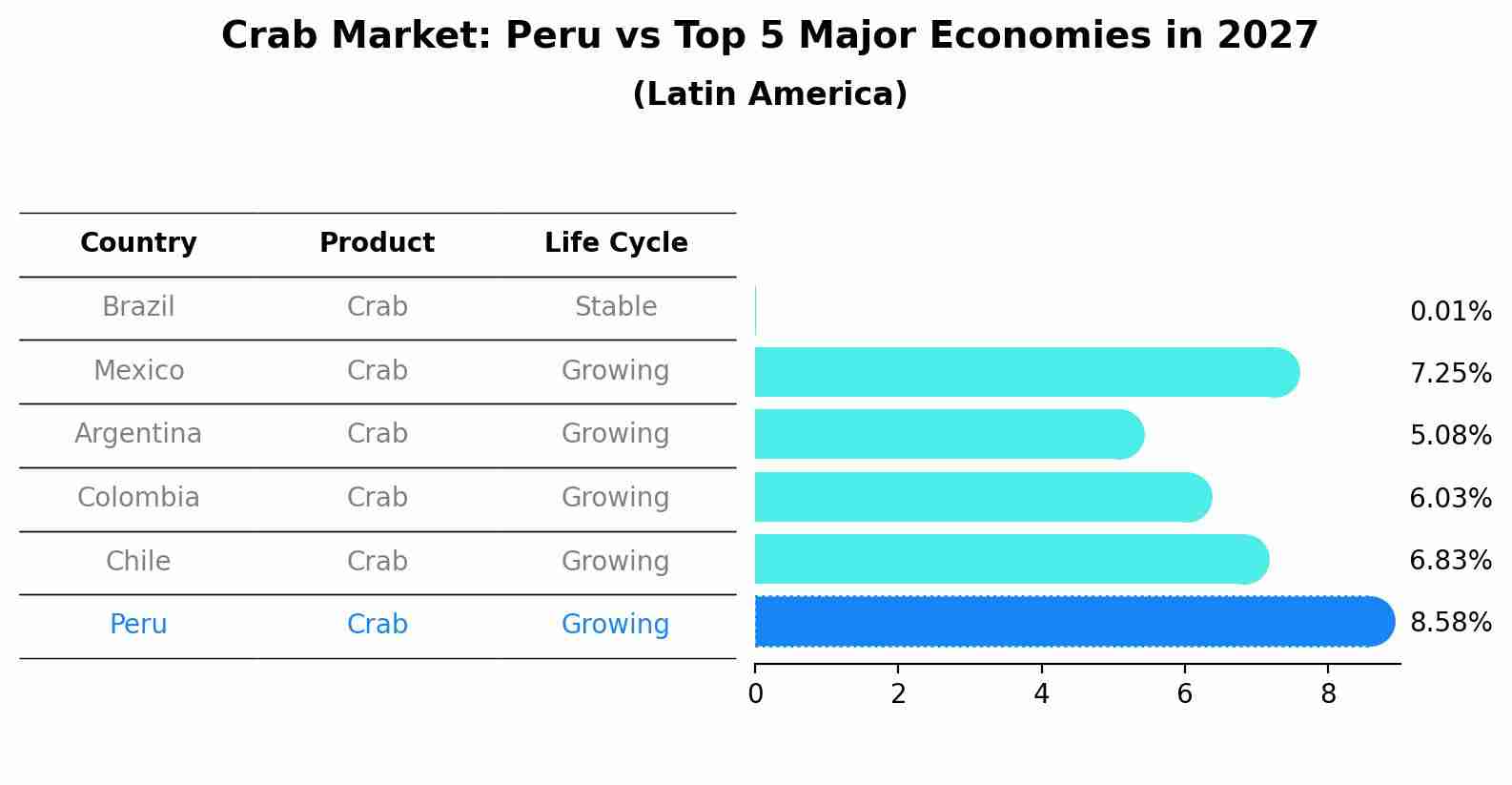Peru Crab Market Outlook | Analysis, Growth, Value, COVID-19 IMPACT, Trends, Forecast, Size, Companies, Share, Revenue & Industry
| Product Code: ETC088825 | Publication Date: Jun 2021 | Updated Date: Jun 2025 | Product Type: Report | |
| Publisher: 6Wresearch | Author: Vasudha | No. of Pages: 70 | No. of Figures: 35 | No. of Tables: 5 |
Peru Crab Market Size Growth Rate
The Peru Crab Market is projected to witness mixed growth rate patterns during 2025 to 2029. The growth rate begins at 8.39% in 2025, climbs to a high of 9.04% in 2026, and moderates to 2.13% by 2029.

Crab Market: Peru vs Top 5 Major Economies in 2027 (Latin America)
By 2027, Peru's Crab market is forecasted to achieve a growing growth rate of 8.58%, with Brazil leading the Latin America region, followed by Mexico, Argentina, Colombia and Chile.

Peru Crab Market Overview
The Peru crab market is characterized by strong demand both domestically and internationally, with a variety of crab species being harvested along the country`s extensive coastline. The most popular crab species in Peru include the Peruvian rock crab, blue crab, and red crab, which are prized for their sweet and delicate meat. The market is driven by a growing consumer preference for seafood, as well as increasing exports to markets such as the United States, Europe, and Asia. However, challenges such as sustainability concerns, competition with other seafood products, and fluctuating market prices pose potential risks to the industry. Overall, the Peru crab market presents opportunities for growth and expansion, particularly with the implementation of sustainable fishing practices and efforts to meet the demands of discerning consumers both locally and globally.
Peru Crab Market Trends
In the Peru Crab Market, there is a growing trend towards sustainable and responsible sourcing practices as consumers become more conscious of the environmental impact of their seafood choices. This has led to an increasing demand for crab products that are certified as being sourced from well-managed fisheries or farms. Additionally, there is a rising interest in value-added crab products such as crab meat and ready-to-eat crab dishes, catering to consumers looking for convenient yet high-quality seafood options. The market is also seeing advancements in packaging and distribution technologies to extend the shelf life of crab products and ensure freshness for consumers. Overall, the Peru Crab Market is evolving to meet the demands of environmentally conscious consumers while also focusing on innovation and convenience in product offerings.
Peru Crab Market Challenges
In the Peru Crab Market, some challenges faced include fluctuating global demand for seafood products, which can impact export opportunities for Peruvian crab producers. Additionally, competition from other crab-producing countries, such as Chile and Ecuador, poses a challenge in terms of pricing and market share. Environmental factors, such as climate change and overfishing, can also affect the availability and sustainability of crab populations in Peru. Furthermore, compliance with international regulations and standards for seafood production and exportation can be a hurdle for Peruvian crab industry players, requiring investments in technology and infrastructure to meet these requirements. Overall, navigating these challenges while maintaining quality, sustainability, and competitiveness in the global market are key concerns for the Peru Crab Market.
Peru Crab Market Investment Opportunities
The Peru Crab Market offers several investment opportunities for individuals looking to capitalize on the growing demand for seafood products. With Peru being a major exporter of crab, investing in crab farming operations or seafood processing facilities could be lucrative options. Additionally, there is potential for investment in technology and equipment that can improve the efficiency and sustainability of crab farming practices. Furthermore, investing in marketing and distribution channels to expand the reach of Peru`s crab products to international markets could also yield significant returns. Overall, the Peru Crab Market presents diverse investment opportunities across various segments of the value chain, making it an attractive sector for investors seeking exposure to the seafood industry.
Peru Crab Market Government Policy
The Peru Crab Market is regulated by various government policies aimed at ensuring sustainability and proper management of crab resources. The government of Peru has implemented regulations such as seasonal closures, size limits, and catch quotas to prevent overfishing and protect crab populations. Additionally, licensing requirements and monitoring programs are in place to control fishing activities and enforce compliance with regulations. The government also collaborates with stakeholders, including fishermen and industry associations, to develop policies that promote responsible crab harvesting practices. Overall, these policies strive to balance economic interests with environmental conservation efforts in the Peru Crab Market.
Peru Crab Market Future Outlook
The future outlook for the Peru Crab Market appears positive, with a steady growth trajectory anticipated in the coming years. Factors such as increasing demand for seafood products globally, the rise in consumer preference for sustainable and healthy food options, and the rich marine biodiversity of Peruâs coastal waters are expected to drive market expansion. The growing popularity of Peruvian cuisine worldwide, known for its use of fresh seafood ingredients, could further boost the demand for Peruâs crab products. Additionally, advancements in fishing technologies and practices, along with government initiatives to promote the sustainable management of marine resources, are likely to support the growth of the Peru Crab Market. Overall, the market is poised for growth, presenting opportunities for industry players to capitalize on the increasing demand for high-quality crab products.
Key Highlights of the Report:
- Peru Crab Market Outlook
- Market Size of Peru Crab Market, 2021
- Forecast of Peru Crab Market, 2027
- Historical Data and Forecast of Peru Crab Revenues & Volume for the Period 2018 - 2027
- Peru Crab Market Trend Evolution
- Peru Crab Market Drivers and Challenges
- Peru Crab Price Trends
- Peru Crab Porter's Five Forces
- Peru Crab Industry Life Cycle
- Historical Data and Forecast of Peru Crab Market Revenues & Volume By Type for the Period 2018 - 2027
- Historical Data and Forecast of Peru Crab Market Revenues & Volume By Blue Crab for the Period 2018 - 2027
- Historical Data and Forecast of Peru Crab Market Revenues & Volume By Chinese Mitten Crab for the Period 2018 - 2027
- Historical Data and Forecast of Peru Crab Market Revenues & Volume By Gazami Crab for the Period 2018 - 2027
- Historical Data and Forecast of Peru Crab Market Revenues & Volume By Others for the Period 2018 - 2027
- Historical Data and Forecast of Peru Crab Market Revenues & Volume By Form for the Period 2018 - 2027
- Historical Data and Forecast of Peru Crab Market Revenues & Volume By Frozen for the Period 2018 - 2027
- Historical Data and Forecast of Peru Crab Market Revenues & Volume By Canned for the Period 2018 - 2027
- Historical Data and Forecast of Peru Crab Market Revenues & Volume By Others for the Period 2018 - 2027
- Peru Crab Import Export Trade Statistics
- Market Opportunity Assessment By Type
- Market Opportunity Assessment By Form
- Peru Crab Top Companies Market Share
- Peru Crab Competitive Benchmarking By Technical and Operational Parameters
- Peru Crab Company Profiles
- Peru Crab Key Strategic Recommendations
Frequently Asked Questions About the Market Study (FAQs):
1 Executive Summary |
2 Introduction |
2.1 Key Highlights of the Report |
2.2 Report Description |
2.3 Market Scope & Segmentation |
2.4 Research Methodology |
2.5 Assumptions |
3 Peru Crab Market Overview |
3.1 Peru Country Macro Economic Indicators |
3.2 Peru Crab Market Revenues & Volume, 2021 & 2027F |
3.3 Peru Crab Market - Industry Life Cycle |
3.4 Peru Crab Market - Porter's Five Forces |
3.5 Peru Crab Market Revenues & Volume Share, By Type, 2021 & 2027F |
3.6 Peru Crab Market Revenues & Volume Share, By Form, 2021 & 2027F |
4 Peru Crab Market Dynamics |
4.1 Impact Analysis |
4.2 Market Drivers |
4.3 Market Restraints |
5 Peru Crab Market Trends |
6 Peru Crab Market, By Types |
6.1 Peru Crab Market, By Type |
6.1.1 Overview and Analysis |
6.1.2 Peru Crab Market Revenues & Volume, By Type, 2018 - 2027F |
6.1.3 Peru Crab Market Revenues & Volume, By Blue Crab, 2018 - 2027F |
6.1.4 Peru Crab Market Revenues & Volume, By Chinese Mitten Crab, 2018 - 2027F |
6.1.5 Peru Crab Market Revenues & Volume, By Gazami Crab, 2018 - 2027F |
6.1.6 Peru Crab Market Revenues & Volume, By Others, 2018 - 2027F |
6.2 Peru Crab Market, By Form |
6.2.1 Overview and Analysis |
6.2.2 Peru Crab Market Revenues & Volume, By Frozen, 2018 - 2027F |
6.2.3 Peru Crab Market Revenues & Volume, By Canned, 2018 - 2027F |
6.2.4 Peru Crab Market Revenues & Volume, By Others, 2018 - 2027F |
7 Peru Crab Market Import-Export Trade Statistics |
7.1 Peru Crab Market Export to Major Countries |
7.2 Peru Crab Market Imports from Major Countries |
8 Peru Crab Market Key Performance Indicators |
9 Peru Crab Market - Opportunity Assessment |
9.1 Peru Crab Market Opportunity Assessment, By Type, 2021 & 2027F |
9.2 Peru Crab Market Opportunity Assessment, By Form, 2021 & 2027F |
10 Peru Crab Market - Competitive Landscape |
10.1 Peru Crab Market Revenue Share, By Companies, 2021 |
10.2 Peru Crab Market Competitive Benchmarking, By Operating and Technical Parameters |
11 Company Profiles |
12 Recommendations |
13 Disclaimer |
- Single User License$ 1,995
- Department License$ 2,400
- Site License$ 3,120
- Global License$ 3,795
Search
Thought Leadership and Analyst Meet
Our Clients
Related Reports
- Afghanistan Apparel Market (2026-2032) | Growth, Outlook, Industry, Segmentation, Forecast, Size, Companies, Trends, Value, Share, Analysis & Revenue
- Canada Oil and Gas Market (2026-2032) | Share, Segmentation, Value, Industry, Trends, Forecast, Analysis, Size & Revenue, Growth, Competitive Landscape, Outlook, Companies
- Germany Breakfast Food Market (2026-2032) | Industry, Share, Growth, Size, Companies, Value, Analysis, Revenue, Trends, Forecast & Outlook
- Australia Briquette Market (2025-2031) | Growth, Size, Revenue, Forecast, Analysis, Trends, Value, Share, Industry & Companies
- Vietnam System Integrator Market (2025-2031) | Size, Companies, Analysis, Industry, Value, Forecast, Growth, Trends, Revenue & Share
- ASEAN and Thailand Brain Health Supplements Market (2025-2031) | Strategy, Consumer Insights, Analysis, Investment Trends, Opportunities, Growth, Size, Share, Industry, Revenue, Segments, Value, Segmentation, Supply, Forecast, Restraints, Outlook, Competition, Drivers, Trends, Demand, Pricing Analysis, Competitive, Strategic Insights, Companies, Challenges
- ASEAN Bearings Market (2025-2031) | Strategy, Consumer Insights, Analysis, Investment Trends, Opportunities, Growth, Size, Share, Industry, Revenue, Segments, Value, Segmentation, Supply, Forecast, Restraints, Outlook, Competition, Drivers, Trends, Demand, Pricing Analysis, Competitive, Strategic Insights, Companies, Challenges
- Europe Flooring Market (2025-2031) | Outlook, Share, Industry, Trends, Forecast, Companies, Revenue, Size, Analysis, Growth & Value
- Saudi Arabia Manlift Market (2025-2031) | Outlook, Size, Growth, Trends, Companies, Industry, Revenue, Value, Share, Forecast & Analysis
- Uganda Excavator, Crane, and Wheel Loaders Market (2025-2031) | Strategy, Consumer Insights, Analysis, Investment Trends, Opportunities, Growth, Size, Share, Industry, Revenue, Segments, Value, Segmentation, Supply, Forecast, Restraints, Outlook, Competition, Drivers, Trends, Demand, Pricing Analysis, Competitive, Strategic Insights, Companies, Challenges
Industry Events and Analyst Meet
Whitepaper
- Middle East & Africa Commercial Security Market Click here to view more.
- Middle East & Africa Fire Safety Systems & Equipment Market Click here to view more.
- GCC Drone Market Click here to view more.
- Middle East Lighting Fixture Market Click here to view more.
- GCC Physical & Perimeter Security Market Click here to view more.
6WResearch In News
- Doha a strategic location for EV manufacturing hub: IPA Qatar
- Demand for luxury TVs surging in the GCC, says Samsung
- Empowering Growth: The Thriving Journey of Bangladesh’s Cable Industry
- Demand for luxury TVs surging in the GCC, says Samsung
- Video call with a traditional healer? Once unthinkable, it’s now common in South Africa
- Intelligent Buildings To Smooth GCC’s Path To Net Zero


















